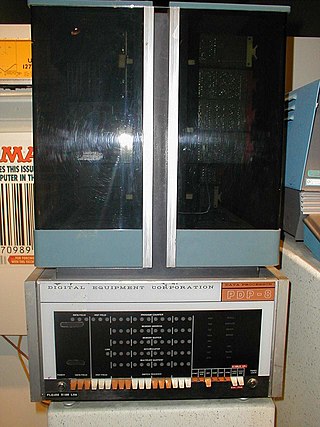Features

The site's intention is to connect screenshots to specific extracts of original code. [6] The author accepts examples submitted by readers for future publication. [1] [2]
Type of site | Geek |
|---|---|
| Owner | John Graham-Cumming |
| URL | moviecode |
| Launched | January 3, 2014 [3] |
| Current status | Online |
MovieCode (full title Source Code in TV and Films) is a website revealing the meanings of computer program source code depicted in film, established in January 2014.
It runs via microblogging site Tumblr, with its owner accepting examples submitted by readers. Its contents include examples of code and their origins and/or meanings.
The site was launched on 3 January 2014 via microblogging service Tumblr. [4] [5] [6] It was conceived by programmer and writer John Graham-Cumming [7] to address questions around what the source code seen in films actually does. [5] [8]
Graham-Cumming was inspired to create the blog by Neill Blomkamp's 2013 film Elysium , which uses an extract from an Intel manual. [6] [9] [10] He posted a comparison image related to the film on Twitter, which prompted more than 500 retweets. He then created the blog. [11] The site's full title of Source Code in TV and Films [3] [7] is sometimes shortened to MovieCode, [12] [13] that being the Tumblr subdomain.
A companion website, Behind The Screens, covers some of the entries on MovieCode in great detail in the form of short videos.

The site's intention is to connect screenshots to specific extracts of original code. [6] The author accepts examples submitted by readers for future publication. [1] [2]
The site was reported by the BBC as having received more than 10,000 hits 10 days after its launch. [3]
The German edition of Engadget was noted for its web site's HTML code being used in Duane Clark's 2011 TV series XIII , [4] [12] while it was noted elsewhere that movie code is frequently taken from web sites, including Wikipedia [5] [14] and a Canadian bank. [10] [14]
It was noted that instead of using "random code" (which is often the case) sometimes more appropriate code is used. [7] Some cited examples are James Cameron's 1984 film The Terminator (using assembly language for the 1975 [15] MOS 6502 microprocessor), [5] Eric Kripke's 2012 TV series Revolution (using code from Jordan Mechner's 1989 video game Prince of Persia ) [12] [16] and David Fincher's [9] 2011 film The Girl with the Dragon Tattoo (using MySQL). [7]

BASIC is a family of general-purpose, high-level programming languages designed for ease of use. The original version was created by John G. Kemeny and Thomas E. Kurtz at Dartmouth College in 1963. They wanted to enable students in non-scientific fields to use computers. At the time, nearly all computers required writing custom software, which only scientists and mathematicians tended to learn.

The Intel 80286 is a 16-bit microprocessor that was introduced on February 1, 1982. It was the first 8086-based CPU with separate, non-multiplexed address and data buses and also the first with memory management and wide protection abilities. The 80286 used approximately 134,000 transistors in its original nMOS (HMOS) incarnation and, just like the contemporary 80186, it could correctly execute most software written for the earlier Intel 8086 and 8088 processors.

The Intel 8080 ("eighty-eighty") is the second 8-bit microprocessor designed and manufactured by Intel. It first appeared in April 1974 and is an extended and enhanced variant of the earlier 8008 design, although without binary compatibility. The initial specified clock rate or frequency limit was 2 MHz, with common instructions using 4, 5, 7, 10, or 11 cycles. As a result, the processor is able to execute several hundred thousand instructions per second. Two faster variants, the 8080A-1 and 8080A-2, became available later with clock frequency limits of 3.125 MHz and 2.63 MHz respectively. The 8080 needs two support chips to function in most applications: the i8224 clock generator/driver and the i8228 bus controller. It is implemented in N-type metal–oxide–semiconductor logic (NMOS) using non-saturated enhancement mode transistors as loads thus demanding a +12 V and a −5 V voltage in addition to the main transistor–transistor logic (TTL) compatible +5 V.

The 8086 is a 16-bit microprocessor chip designed by Intel between early 1976 and June 8, 1978, when it was released. The Intel 8088, released July 1, 1979, is a slightly modified chip with an external 8-bit data bus, and is notable as the processor used in the original IBM PC design.

A minicomputer, or colloquially mini, is a type of smaller general-purpose computer developed in the mid-1960s and sold at a much lower price than mainframe and mid-size computers from IBM and its direct competitors. In a 1970 survey, The New York Times suggested a consensus definition of a minicomputer as a machine costing less than US$25,000, with an input-output device such as a teleprinter and at least four thousand words of memory, that is capable of running programs in a higher level language, such as Fortran or BASIC.

CP/M, originally standing for Control Program/Monitor and later Control Program for Microcomputers, is a mass-market operating system created in 1974 for Intel 8080/85-based microcomputers by Gary Kildall of Digital Research, Inc. Initially confined to single-tasking on 8-bit processors and no more than 64 kilobytes of memory, later versions of CP/M added multi-user variations and were migrated to 16-bit processors.

The KIM-1, short for Keyboard Input Monitor, is a small 6502-based single-board computer developed and produced by MOS Technology, Inc. and launched in 1976. It was very successful in that period, due to its low price and easy-access expandability.

Syntax highlighting is a feature of text editors that are used for programming, scripting, or markup languages, such as HTML. The feature displays text, especially source code, in different colours and fonts according to the category of terms. This feature facilitates writing in a structured language such as a programming language or a markup language as both structures and syntax errors are visually distinct. This feature is also employed in many programming related contexts, either in the form of colorful books or online websites to make understanding code snippets easier for readers. Highlighting does not affect the meaning of the text itself; it is intended only for human readers.
An object file is a computer file containing object code, that is, machine code output of an assembler or compiler. The object code is usually relocatable, and not usually directly executable. There are various formats for object files, and the same machine code can be packaged in different object file formats. An object file may also work like a shared library.
A processor register is a quickly accessible location available to a computer's processor. Registers usually consist of a small amount of fast storage, although some registers have specific hardware functions, and may be read-only or write-only. In computer architecture, registers are typically addressed by mechanisms other than main memory, but may in some cases be assigned a memory address e.g. DEC PDP-10, ICT 1900.
The TMS9900 was one of the first commercially available, single-chip 16-bit microprocessors. Introduced in June 1976, it implemented Texas Instruments' TI-990 minicomputer architecture in a single-chip format, and was initially used for low-end models of that lineup.

John Graham-Cumming is a British software engineer and writer best known for starting a successful petition to the Government of the United Kingdom asking for an apology for its persecution of Alan Turing. As of 2020, he serves as Chief Technology Officer (CTO) at Cloudflare; previously he worked at Electric Cloud.
Microblogging is a form of blogging using short posts without titles. Microblogs "allow users to exchange small elements of content such as short sentences, individual images, or video links", which may be the major reason for their popularity. Some popular social networks such as Twitter, Mastodon, and Instagram can be viewed as collections of microblogs.

Boxee was a cross-platform freeware HTPC software application with a 10-foot user interface and social networking features designed for the living-room TV. It enabled its users to view, rate and recommend content to their friends through many social network services and interactive media related features.

Tumblr is a microblogging and social networking website founded by David Karp in 2007 and currently owned by American company Automattic. The service allows users to post multimedia and other content to a short-form blog. Users can follow other users' blogs. Bloggers can also make their blogs private. For bloggers, many of the website's features are accessed from a "dashboard" interface. As of March 2023, Tumblr hosts more than 572 million blogs.

Voddler was a Stockholm, Sweden-based provider of a video-on-demand (VOD) platform and a streaming technology for over-the-top (OTT) streaming on the public Internet. In Scandinavia, Voddler was primarily known for the commercial VOD-service Voddler, which was launched in 2009. As a company, Voddler was founded in 2005 and developed its own streaming solution, called Vnet. Vnet is based on peer-to-peer (p2p), where all users contribute by streaming movies to each other, but, unlike traditional p2p, Vnet has a central administrator who decides which users that have access to which movies. Due to this exception, Vnet has been referred to as a "hybrid p2p distribution system", "walled garden p2p" or "controlled p2p". In addition to running the consumer service Voddler, the company Voddler also offers, since 2013, Vnet as a stand-alone technology for other streaming platforms. The service Bollyvod, a global VOD-service for Bollywood-content that Voddler built for the Indian movie industry, was released as a pilot in 2014.
A binary recompiler is a compiler that takes executable binary files as input, analyzes their structure, applies transformations and optimizations, and outputs new optimized executable binaries.

Twister is a decentralised, experimental peer-to-peer microblogging program. The system uses end-to-end encryption to safeguard communications. It is based on both BitTorrent- and Bitcoin-like protocols and has been likened to a distributed version of Twitter.
Micro.blog is a microblogging and social networking service created by Manton Reece. It is the first large multi-user social media service to support the Webmention and Micropub standards published by the World Wide Web Consortium, and is part of the Fediverse, supporting ActivityPub.